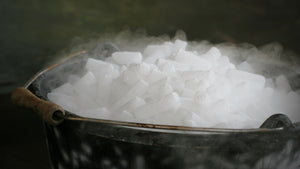Dry ice is a versatile and powerful tool with a wide range of applications, from keeping perishables cold during transport to creating stunning special effects. If you're new to using dry ice, it's essential to understand what it is, how to handle it safely, how long it will last in various conditions, and how to make the most of its unique properties.

What is Dry Ice?
Dry ice is the solid form of carbon dioxide (CO2), a gas that's naturally present in the Earth's atmosphere. Unlike regular ice, dry ice doesn't melt into a liquid but instead sublimates--turns directly from a solid to a gas at -109.3°F (-78.5°C). This property makes it incredibly useful for cooling purposes, as it leaves no liquid residue.
General Safety Tips for Handling Dry Ice
While dry ice can be extremely helpful, it must be handled with care due to its extremely cold temperature. Here are some essential safety tips to keep in mind:
- Wear Protective Gear: Always use insulated gloves or tongs when handling dry ice to prevent frostbite. Even brief skin contact can cause burns similar to those from heat.
- Use in Well-Ventilated Areas: Dry ice sublimates into carbon dioxide gas, which can displace oxygen in confined spaces. Ensure good ventilation when using dry ice indoors to prevent CO2 buildup, which can be dangerous.
- Keep Out of Reach of Children and Pets: Dry ice is not a toy. Keep it away from children and pets to avoid accidental injury.
- Do Not Ingest: Dry ice should never be consumed. While it's sometimes used in food and drink presentations for effect, it must not come into direct contact with what you eat or drink.
Common Uses of Dry Ice and How to Use It
Cooling and Preserving Food
One of the most common uses of dry ice is keeping food cold during transport or storage. Whether you're shipping perishable items or packing a cooler for a camping trip, dry ice can help maintain low temperatures without the mess of melting ice.
- Instructions: Place dry ice at the bottom of the cooler, then cover it with a layer of insulating material such as newspaper or cardboard. Pack your food on top. Be sure to leave some space for the gas to escape, and don't completely seal the cooler, as the build up of gas could cause it to explode.
- Watch Out For: Don't store dry ice in a completely airtight container. As it sublimates, the gas needs somewhere to go. Failure to vent the container could result in a dangerous buildup of pressure.
Creating Fog Effects
Dry ice is often used to create spooky fog effects for Halloween parties or theatrical performances. When dry ice is combined with warm water, it produces thick, white fog that lingers close to the ground.
- Instructions: Place a few pieces of dry ice in a container and slowly add hot water. The fog will start to form almost immediately. For a continuous effect, keep adding hot water as needed.
- Watch Out For: Be careful not to touch the dry ice directly with your hands when adding it to the water, and ensure that the container is open to allow the gas to escape safely.
Removing Car Dents
Dry ice can also be used to remove minor dents from car surfaces. The rapid cooling of the metal causes it to contract, potentially popping the dent out.
- Instructions: First, heat the dented area with a hairdryer for about 30 seconds. Then, wearing gloves, rub the dry ice over the dent in a circular motion. The dent should pop out as the metal contracts.
- Watch Out For: This method may not work for all dents, and using dry ice on older or already brittle paint could cause damage.
How Long Does Dry Ice Last?
Dry ice sublimates relatively quickly, so how long it lasts depends on several factors, including the container you use, the environmental temperature, and how much dry ice you have. Here's a general guideline for how long you can expect dry ice to last under different conditions:
- In a Styrofoam Cooler: Styrofoam coolers are commonly used for dry ice storage because of their insulating properties. In a standard 25-quart Styrofoam cooler, 5-10 pounds of dry ice will typically last for about 18-24 hours, depending on the outside temperature and how frequently the cooler is opened.
- In a Hard-Sided Cooler (like Yeti or Igloo): High-quality hard-sided coolers have better insulation than Styrofoam. If you use 5-10 pounds of dry ice, it can last up to 24-48 hours in a well-insulated hard-sided cooler, especially if the cooler is not opened frequently and kept in a cool environment.
- In a Refrigerator or Freezer (When the Power is Out): If you're using dry ice to keep your refrigerator or freezer cold during a power outage, about 10-20 pounds will last 12-24 hours in a refrigerator, and 24-48 hours in a freezer. Place the dry ice on the top shelf to allow the cold air to circulate downward.
- In Open Air: If dry ice is left exposed in an open area, it will sublimate much faster. For example, a 5-pound block of dry ice left in open air at room temperature will typically last 3-5 hours before fully sublimating.
Remember that these times are estimates. Factors like the size of the container, the amount of dry ice, and the surrounding temperature will impact how long the dry ice lasts.
Proper Disposal of Dry Ice
Once you're done using dry ice, you need to dispose of it properly. Never throw dry ice in the trash, sink, or toilet, as it can cause damage and create a dangerous buildup of gas.
- Instructions: The safest way to dispose of dry ice is to allow it to sublimate in a well-ventilated area. Place the remaining dry ice in an open container in a space where pets and children cannot access it. It will gradually turn back into CO2 gas and dissipate.
Need Dry Ice? Contact Baker's Dry Ice!
Whether you need dry ice for a special event, shipping, or a DIY project, Baker's Dry Ice in Jackson, MI, is here to help. We provide high-quality dry ice for a variety of uses and can guide you on how to use it safely and effectively. Reach out to us for all your dry ice needs!




